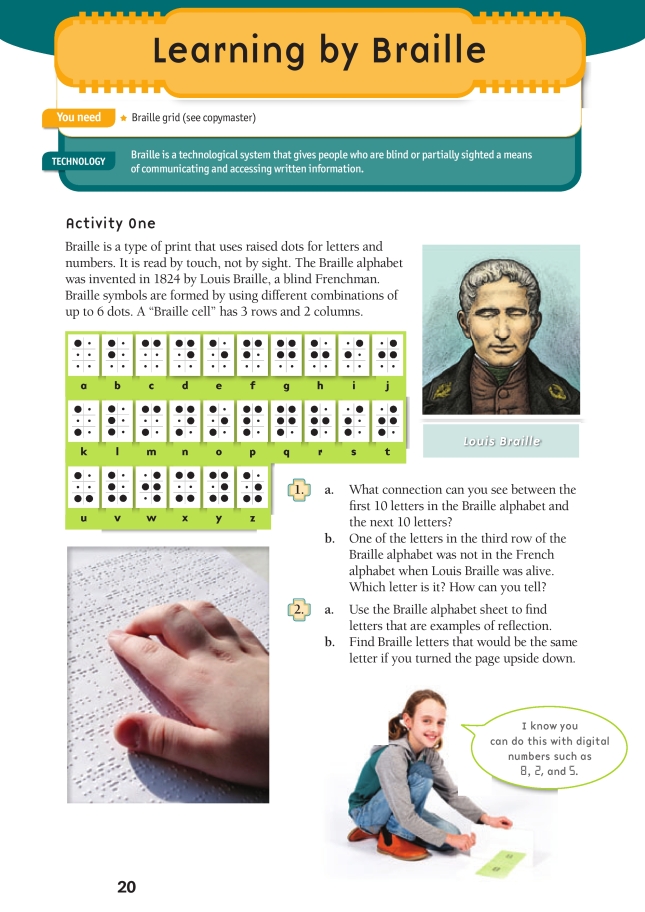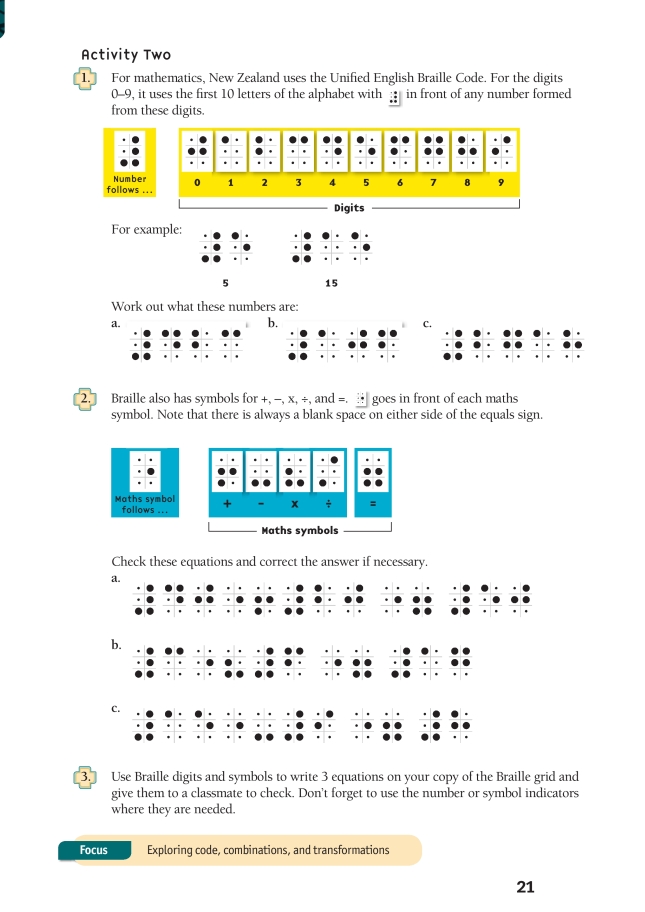This is a level 3 activity from the Figure It Out series.
A PDF of the student activity is included.
Click on the image to enlarge it. Click again to close. Download PDF (224 KB)
Finding patterns and relationships is an important mathematical skill and one that often produces a sense of pleasure or satisfaction. In these activities, students explore patterns in the Braille alphabet and observe the systematic approach that Louis Braille used when creating the symbols. They also learn how the Braille system has been adapted for use in mathematics.
FIO, Technology Rules!, Levels 2+-3+, Learning by Braille, pages 20 - 21
In these activities, students examine the Braille alphabet, looking for patterns and examples of symmetry.
Explore examples of reflective symmetry in the Latin alphabet, for example, A, M, and E. Discuss whether the reflections are horizontal or vertical.
Some letters have rotational symmetry, for example, N and S. Others have both reflective symmetry and rotational symmetry, for example, H and X.
The symbol for W can be used to introduce the idea of “special cases” – a single instance when a generalised rule does not work.
Exploring alternative ways of denoting letters, numbers, and symbols develops the key competency using language, symbols, and text.
Technology-related student activities
- Interview a visually impaired person who can read Braille to discover the positive and/or negative aspects of the code.
- Have students identify a particular key on a computer keyboard, place a finger on another key, close their eyes, and attempt to locate that letter by touch. Have them try to spell out their name by this method. Some keyboards have raised areas to assist visually impaired people.
- Suggest and develop other ways of communicating with blind people. For instance, they could make a simple electrical circuit with a switch and a buzzer. This could then be used to send a code message. Students could investigate international codes, such as Morse.
- Identify hazards for blind people in the community and ways in which they may be assisted to avoid those hazards. For instance, tactile ground surface indicators (TGSI) (panels with raised dots) are often placed at pedestrian crossings.
- Design a board game for a blind person or modify an existing one.
Useful websites include:
www.braillebookstore.com
www.nyise.org/blind/barbier.htm
Exploring the technology-related context
The development of language and symbols has been crucial for technological innovation. With the development of non-verbal ways to express themselves and record ideas, designers were able to reach and inform large numbers of people, who could, perhaps, extend or modify the original ideas. With the advent of the printing press in the fifteenth century, the audience became global, and the pace of technological innovation picked up greatly.
Braille became the means for blind people to access written material. Like most new technologies, it was influenced by previous developments; other codes and language constructions helped Louis Braille produce an effective code.
Technology is about meeting needs, responding to opportunities, and solving problems. Louise Braille achieved all three. Today, as well as books and other written material, some banknotes and building signs have information written in Braille.
Answers
Activity One
1. a. The second 10 letters are the same as the first 10 letters, with the addition of another dot in the bottom left corner (first column, third row).
b. The “w” does not follow the pattern. All the other letters in the third row are the same as the letters in the second row, but with another dot in the bottom right corner. (Note that the pattern of the letters after “w” is shifted across in the grid, m→x, n→y, o→z.)
2. a. The letters that reflect down the centre line are: c, g, and x. The letters that reflect through an imaginary line through the middle of row 2 are: k, l, o, r, w, x and y.
b. t and x (t and x have half-turn rotational symmetry.)
Activity Two
1. a. 423
b. 106
c. 2718
2. a. The answer should be ![]()
so that the equation is 40 + 20 = 60.
b. The answer should be ![]()
so that the equation is 3 x 6 = 18.
c. The answer should be ![]()
so that the equation is 15 – 9 = 6.
3. Equations will vary.

